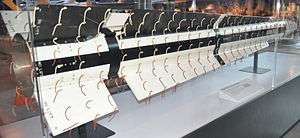AGM-76 Falcon

The AGM-76 Falcon is an air-to-surface missile developed by the United States of America.
Overview
The AGM-76 was developed as a ground attack version of the AIM-47 Falcon air-to-air missile, in much the same way that the AGM-87 Focus was developed from the AIM-9 Sidewinder. It was planned to use the AGM-76 to equip the Mach 3 capable North American F-108 fighter. Although the F-108 was ultimately cancelled the AN/ASG-18 fire-control system was transferred to the Lockheed YF-12, allowing that aircraft to handle the AIM-47 and AGM-76. Twenty-two XAGM-76A prototype missiles were built; ten of these were test fired from YF-12A prototypes.
Guidance for the missile was provided by the AN/ASG-18 Fire-Control System, which was modified to allow it to operate in the air to ground role. The AGM-76 had a range in excess of 160 kilometres (99 mi). The 250 kiloton thermonuclear warhead would normally be detonated in an air burst above the target.
The test firings were generally successful, and the USAF planned to acquire the production missiles for the F-12B in order to allow it to perform in the high speed nuclear strike mission. When the F-12B was cancelled, the AGM-76 program was also halted.
Specifications
- Length : 3.20 m (10 ft 6 in)
- Wingspan : 0.838 m (2 ft 9.0 in)
- Diameter : 0.335 m (1-foot 1.2 in)
- Speed : Mach 4+ (4,240 km/h or 2,630 mph)
- Range : > 160 kilometres (99 miles)
- Warhead : 250 kt thermonuclear
Operators
-
 United States: The United States Air Force cancelled the AGM-76 prior to service entry.
United States: The United States Air Force cancelled the AGM-76 prior to service entry.